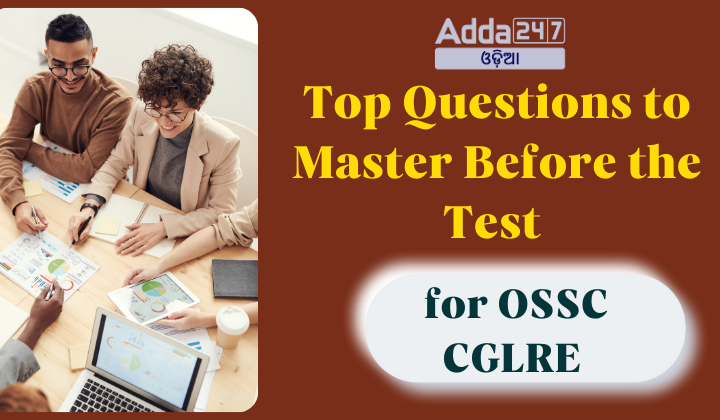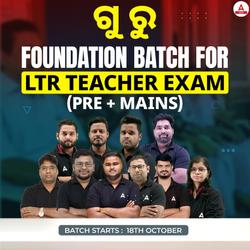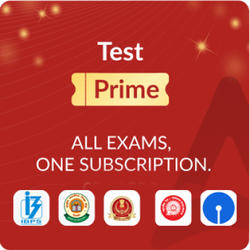Preparing for the OSSC CGLRE (Odisha Staff Selection Commission Combined Graduate Level Recruitment Examination) requires a well-rounded understanding of key topics. To succeed, candidates should focus on mastering questions from areas like General Awareness, Arithmetic, Logical Reasoning, and Computer Knowledge. General Awareness involves current affairs, Odisha history, and basic knowledge of Indian politics and economy. Arithmetic questions focus on problem-solving skills, covering algebra, geometry, and data interpretation. Logical reasoning tests a candidate’s analytical and critical thinking abilities, while Computer Knowledge emphasizes basic operations and functions. Practice and understanding these topics will help boost your confidence and ensure a high score.
Top Questions to Master Before the OSSC CGL Test: 16 October 2024
- Find the greatest number that will divide 43, 91, and 183 so as to leave the same remainder in each case.
(a) 4
(b) 7
(c) 9
(d) 13
Ans: (a)
Explanation: Required number = H.C.F. of (91 – 43), (183 – 91), and (183 – 43)
= H.C.F. of 48, 92, and 140 = 4. - The H.C.F. of two numbers is 23, and the other two factors of their L.C.M. are 13 and 14. The larger of the two numbers is:
(a) 276
(b) 299
(c) 322
(d) 345
Ans: (c)
Explanation: The numbers are (23 × 13) and (23 × 14).
Larger number = (23 × 14) = 322. - Six bells commence tolling together and toll at intervals of 2, 4, 6, 8, 10, and 12 seconds respectively. In 30 minutes, how many times do they toll together?
(a) 4
(b) 10
(c) 15
(d) 16
Ans: (d)
Explanation: L.C.M. of 2, 4, 6, 8, 10, and 12 is 120 seconds (2 minutes).
In 30 minutes, they will toll together 30/2 + 1 = 16 times. - Let N be the greatest number that will divide 1305, 4665, and 6905, leaving the same remainder in each case. Then the sum of the digits in N is:
(a) 4
(b) 5
(c) 6
(d) 8
Ans: (a)
Explanation: N = H.C.F. of (4665 – 1305), (6905 – 4665), and (6905 – 1305)
= H.C.F. of 3360, 2240, and 5600 = 1120.
Sum of digits in N = (1 + 1 + 2 + 0) = 4. - The greatest number of four digits which is divisible by 15, 25, 40, and 75 is:
(a) 9000
(b) 9400
(c) 9600
(d) 9800
Ans: (c)
Explanation: The greatest number of 4 digits is 9999.
L.C.M. of 15, 25, 40, and 75 is 600.
On dividing 9999 by 600, the remainder is 399.
Required number = (9999 – 399) = 9600. - A person crosses a 600 m long street in 5 minutes. What is his speed in km per hour?
(a) 3.6
(b) 7.2
(c) 8.4
(d) 10
Ans: (b)
Explanation:
- An aeroplane covers a certain distance at a speed of 240 kmph in 5 hours. To cover the same distance in 1 hour, it must travel at a speed of:
(a) 300 kmph
(b) 360 kmph
(c) 600 kmph
(d) 720 kmph
Ans: (d)
Explanation:
- If a person walks at 14 km/hr instead of 10 km/hr, he would have walked 20 km more. The actual distance travelled by him is:
(a) 50 km
(b) 56 km
(c) 70 km
(d) 80 km
Ans: (a)
Explanation:
- A train can travel 50% faster than a car. Both start from point A at the same time and reach point B, 75 kms away from A, at the same time. On the way, however, the train lost about 12.5 minutes while stopping at the stations. The speed of the car is:
(a) 100 kmph
(b) 110 kmph
(c) 120 kmph
(d) 130 kmph
Ans: (c)
Explanation:
- Excluding stoppages, the speed of a bus is 54 kmph and including stoppages, it is 45 kmph. For how many minutes does the bus stop per hour?
(a) 9
(b) 10
(c) 12
(d) 20
Ans: (b)
Explanation:
- A family consists of six members A, B, C, D, E, and F. A is the father of B, but B is not his son. C is the sister of B. D is the son of A. E is the wife of A. F is the son of E. Who is B?
(a) Daughter
(b) Son
(c) Cousin
(d) Uncle
Ans: (a) Daughter
Solution: Since B is not A’s son, B must be his daughter. - If it was a Thursday on 1st January 2015, what was the day on 31st December 2014?
(a) Tuesday
(b) Wednesday
(c) Thursday
(d) Monday
Ans: (b) Wednesday
Solution: 31st December 2014 was one day before 1st January 2015, hence Wednesday. - In a row of boys, Ravi is 10th from the left and Suresh is 7th from the right. If they interchange their positions, Ravi becomes 15th from the left. How many boys are there in the row?
(a) 18
(b) 20
(c) 22
(d) 24
Ans: (b) 20
Solution: The total number of boys = Ravi’s new position + Suresh’s old position – 1 = 15 + 7 – 1 = 21 – 1 = 20. - A man travels 6 km north, then turns left and travels 4 km, then turns left and travels 6 km, and finally turns left and travels 2 km. How far is he from the starting point?
(a) 2 km
(b) 4 km
(c) 6 km
(d) 8 km
Ans: (a) 2 km
Solution: The final position is 2 km south of the starting point. - What is the logical and meaningful order for the following words?
1.Bronze
2.Gold
3.Silver
4.Platinum
5.Iron
(a) 3, 1, 5, 2, 4
(b) 5, 1, 3, 2, 4
(c) 2, 1, 5, 3, 4
(d) 5, 4, 3, 2, 1
Answer: (b) 5, 1, 3, 2, 4
Solution:
Iron is the most common and least valuable metal in the list.
Bronze is an alloy of copper and tin, often considered more valuable than iron.
Silver is a precious metal with more value than bronze.
Gold is more valuable than silver.
Platinum is the most valuable and rarest metal in the list.
The correct logical order based on increasing value is Iron → Bronze → Silver → Gold → Platinum. - Arrange the given words in a logical and meaningful order:
1.Book
2.Seller
3.Idea
4.Feedback
5.Reader
(a) 4, 1, 2, 3, 6, 5
(b) 4, 1, 2, 6, 3, 5
(c) 4, 1, 3, 6, 5, 2
(d) 4, 1, 2, 6, 5, 3
Answer: (d) 4, 1, 2, 6, 5, 3
Solution:
Idea is the starting point.
Book is the result of the idea being written down.
Seller sells the book to the public.
Reader reads the book.
Feedback is provided by the reader.
The correct sequence is Idea → Book → Seller → Reader → Feedback. - Choose the odd one out: Cherry, Apple, Banana, Grape
(a) Cherry
(b) Apple
(c) Banana
(d) Grape
Answer: (c) Banana
Solution: Banana is the only fruit that is technically a berry, while others are not. - If a clock shows the time as 8:00 PM, what is the angle between the hour and minute hands?
(a) 240 degrees
(b) 120 degrees
(c) 180 degrees
(d) 90 degrees
Answer: (a) 240 degrees
Solution: The angle between the hour and minute hands = |(30*hour – (11/2)minutes)| = |(308 – (11/2)*0)| = 240 degrees. - A man walks 5 km towards the north and then turns to the right. After walking 3 km, he turns to the right and walks 5 km. Then, he turns to the left and walks 5 km. How far is he from the starting point?
(a) 5 km
(b) 10 km
(c) 13 km
(d) 8 km
Ans: (d) 8 km
Solution: The man is 8 km away from the starting point diagonally. - Rahul walks 30 meters towards the north, then turns right and walks 40 meters. He then turns right and walks 20 meters, and finally turns right and walks 40 meters. How far is he from the starting point?
(a) 10 meters
(b) 20 meters
(c) 30 meters
(d) 40 meters
Ans: (a) 10 meters
Solution: Rahul is 10 meters north of the starting point. - What does IP stand for?
(a) Internet Protocol
(b) Internal Protocol
(c) Integrated Protocol
(d) Intercom Protocol
Ans: (a) Internet Protocol - Which protocol translates domain names to IP addresses?
(a) FTP
(b) HTTP
(c) DNS
(d) UDP
Ans: (c) DNS - Which browser is commonly used for accessing the World Wide Web?
(a) Firefox
(b) FTP
(c) Telnet
(d) TCP
Ans: (a) Firefox - What year saw the introduction of the web browser?
(a) 1969
(b) 1980
(c) 1990
(d) 2000
Ans: (c) 1990 - Which protocol ensures reliable transmission of data packets?
(a) IP
(b) HTTP
(c) TCP
(d) UDP
Ans: (c) TCP - Which internet service is used for remote login?
(a) FTP
(b) Telnet
(c) HTTP
(d) DNS
Ans: (b) Telnet - Which type of malware blocks access to a computer system until a ransom is paid?
(a) Spyware
(b) Virus
(c) Ransomware
(d) Adware
Ans: (c) Ransomware - Which internet service allows the transfer of files between devices?
(a) HTTP
(b) Telnet
(c) FTP
(d) DNS
Ans: (c) FTP - Which organization first conceptualized the ARPANET?
(a) Department of Defense (USA)
(b) Microsoft Corporation
(c) Google Inc.
(d) Apple Inc.
Ans: (a) Department of Defense (USA) - What does HTTP stand for?
(a) HyperText Transfer Product
(b) HyperText Transfer Protocol
(c) High Transmission Protocol
(d) High-Resolution Transfer Product
Ans: (b) HyperText Transfer Protocol - Which area in Odisha saw a significant decline in youth unemployment in 2023-24?
(a) Urban areas
(b) Rural areas
(c) Coastal areas
(d) Industrial areas
Ans: (b) Rural areas
Explanation: Rural Odisha saw a significant decline in youth unemployment, dropping from 12.7% in 2022-23 to 9.3% in 2023-24. - What was the unemployment rate in urban Odisha for youth in 2023-24?
(a) 21.8%
(b) 22.9%
(c) 10.2%
(d) 11.1%
Ans: (b) 22.9%
Explanation: The youth unemployment rate in urban Odisha increased slightly to 22.9% in 2023-24, up from 21.8% in 2022-23. - Which organization conducts the Periodic Labour Force Survey (PLFS)?
(a) NITI Aayog
(b) National Statistical Office (NSO)
(c) Ministry of Labour
(d) Reserve Bank of India
Ans: (b) National Statistical Office (NSO)
Explanation: The PLFS is conducted by the National Statistical Office (NSO) to provide data on employment and unemployment rates. - In which category did Odisha score the highest in the Urban Governance Index (UGI) 2024?
(a) Empowerment of elected representatives
(b) Fiscal empowerment
(c) Empowered citizens
(d) City administration
Ans: (c) Empowered citizens
Explanation: Odisha topped the “Empowered citizens” category, scoring 21 out of 25 points in the Urban Governance Index 2024. - What is the overall score of Odisha in the Urban Governance Index 2024?
(a) 59
(b) 55
(c) 50
(d) 42
Ans: (b) 55
Explanation: Odisha scored 55 points out of 100 in the Urban Governance Index 2024. - Which state ranked first in the Urban Governance Index 2024?
(a) Odisha
(b) Maharashtra
(c) Kerala
(d) Madhya Pradesh
Ans: (c) Kerala
Explanation: Kerala ranked first in the Urban Governance Index 2024 with 59 points. - How many new Primary Agricultural Credit Societies (PACS) will be set up in Odisha as part of its agriculture modernization efforts? (a) 1,200
(b) 2,542
(c) 3,000
(d) 4,500
Ans: (b) 2,542
Explanation: The Odisha government plans to establish 2,542 new PACS to improve paddy procurement and support farmers. - Why are anti-poaching camps being set up around Chilika Lake?
(a) To protect migratory birds
(b) To safeguard fish species
(c) To promote tourism
(d) To preserve local traditions
Ans: (a) To protect migratory birds
Explanation: Anti-poaching camps have been set up around Chilika Lake to protect migratory birds that visit the lake during winter. - What type of ecosystem is Chilika Lake?
(a) Freshwater lake
(b) Brackish water lagoon
(c) Saltwater ocean
(d) Desert oasis
Ans: (b) Brackish water lagoon
Explanation: Chilika Lake is the largest brackish water lagoon in Asia, and the second largest in the world. - What is the significance of Khandagiri caves?
(a) They were used as a Hindu temple.
(b) They are a popular tourist destination with Buddhist sculptures.
(c) They served as a Jain monastery with intricate carvings.
(d) They house royal family treasures.
Ans: (c) They served as a Jain monastery with intricate carvings.
Explanation: The Khandagiri caves are ancient Jain rock-cut caves with detailed carvings of religious figures.
Q(41-43): The following pie chart give the information about the distribution of weight in the human body according to different kinds of components. Study the pie charts and answer the question.

41. What percentage of proteins in the human body is equivalent to the weight of its skin?
A) 41.66%
B) 43.33%
C) 44.44%
D) Cannot be determined
Answer: A) 41.66%
Explanation:
Total percentage = (10 / 24) x 100 = 41.6666667 %
42. How much of the human body is neither made of bones nor skin?
A) 40%
B) 50%
C) 60%
D) 70%
Answer: D) 70%
Explanation:
20% (bones) + 10% (skin) = 30% of the body is made up of either bones or skin. Hence, 70% is made up of neither.
43. What is the ratio of the distribution of proteins in the muscles to that of the distribution of proteins in the bones?
A) 2:1
B) 2:3
C) 3:2
D) Cannot be determined
Answer: D) Cannot be determined
Explanation:
It cannot be determined since the respective distributions are not known.
Q(44-45): The following pie charts display the distribution of overseas tourist traffic from India. The first chart illustrates the tourist distribution by country, while the second chart presents the age profiles of these tourists.

44. The ratio of the number of Indian tourists that went to the USA to the number of Indian tourists who were below 30 years of age is:
a) 2:1
b) 8:3
c) 3:8
d) Cannot be determined
Answer: Option b) 8:3
Explanation:
Given ratio is 40:15, which simplifies to 8:3.
45. If amongst other countries, Switzerland accounted for 25% of the Indian tourist traffic, and it is known from official Swiss records that a total of 25 lakh Indian tourists had gone to Switzerland during the year, then find the number of 30-39 year old Indian tourists who went abroad in that year:
a) 18.75 lakh
b) 25 lakh
c) 50 lakh
d) 75 lakh
Answer: Option d) 75 lakh
Explanation: Tourist traffic from other countries to Swiz is 20%.
Amongst this 20%, 25% of traffic from India.
So, 25% of 20% = 5% corresponds to the Indian traffic in Switzerland.
5 % corresponds to Switzerland’s 25 lakh. Hence 15% will be 75 lakh.
Q(46-50): The line graph illustrates the ratio of a company’s imports to its exports from 1995 to 2001. This shows how the import-export balance of the company has evolved over the years.

46. What was the imports in 1999, given that imports in 1998 were Rs. 250 crores and the total exports in 1998 and 1999 together was Rs. 500 crores?
A) Rs. 250 crores
B) Rs. 300 crores
C) Rs. 357 crores
D) Rs. 420 crores
Answer: B) Rs. 300 crores
Explanation: The ratio of imports to exports for the years 1998 and 1999 are 1.25 and 1.40 respectively.
Let the exports in the year 1998 = Rs. x crores.
Then, the exports in the year 1999 = Rs. (500 – x) crores.
Therefore 1.25 = 250/ X => x =250/ 1.25= 200 [Using ratio for 1998]
Thus, the exports in the year 1999 = Rs. (500 – 200) crores = Rs. 300 crores.
Let the imports in the year 1999 = Rs. y crores.
Then, 1.40 = y/300 => y = (300 x 1.40) = 420.
Therefore Imports in the year 1999 = Rs. 420 crores.
47. In which year were the imports minimum proportionate to the exports of the company?
A) 1995
B) 1996
C) 1997
D) 2000
Answer: C) 1997
Explanation: The imports are minimum proportionate to the exports implies that the ratio of the value of imports to exports has the minimum value.
Now, this ratio has a minimum value 0.35 in 1997, i.e., the imports are minimum proportionate to the exports in 1997.
48. What was the percentage increase in imports from 1997 to 1998?
A) 72
B) 56
C) 28
D) Data inadequate
Answer: D) Data inadequate
Explanation: The graph gives only the ratio of imports to exports for different years. To find the percentage increase in imports from 1997 to 1998, we require more details such as the value of imports or exports during these years.
Hence, the data is inadequate to answer this question.
49. If the imports of the company in 1996 was Rs. 272 crores, what were the exports from the company in 1996?
A) Rs. 370 crores
B) Rs. 320 crores
C) Rs. 280 crores
D) Rs. 275 crores
Answer: B) Rs. 320 crores
Explanation: Ratio of imports to exports in the year 1996 = 0.85.
Let the exports in 1996 = Rs. x crores.
Then, 272/X = 0.85 => x = 272/0.85 = 320.
Therefore Exports in 1996 = Rs. 320 crores.
50. In how many of the given years were the exports more than the imports?
A) 1
B) 2
C) 3
D) 4
Answer: D) 4
Explanation:
Exports greater than imports ratio in 1995, 1996, 1997, and 2000










